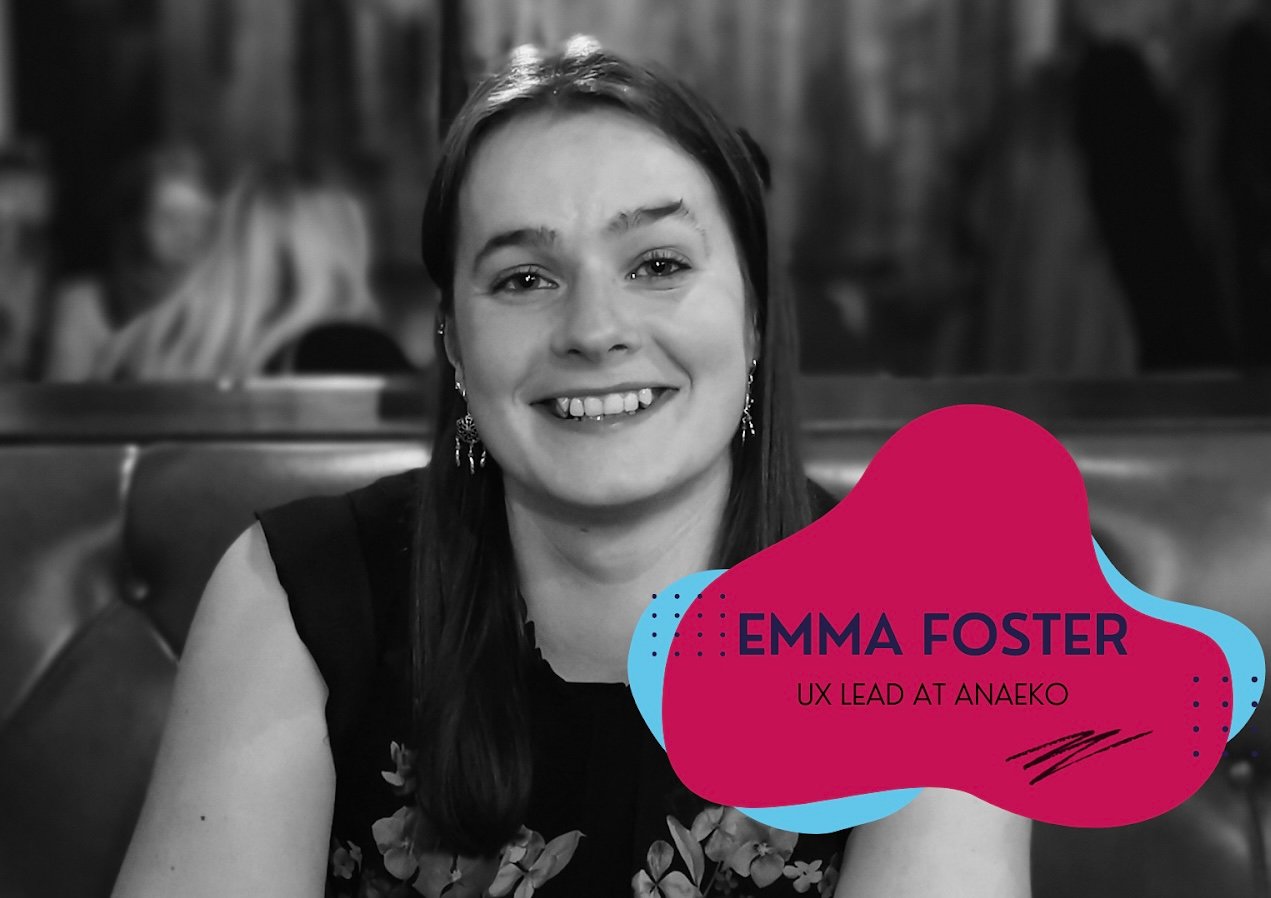Emma Foster has worked in the tech industry for over a decade, taking on various roles within her career from web design to digital marketing. Emma’s vast experience has led to her current UX Lead position at Anaeko .

WHAT IS A UX LEAD
UX stands for “user experience” and, as you might imagine, UX is critical to both the customer experience and the success of modern web and mobile applications. Increasingly, companies are seeking UX specialists to help improve sales and build their business.
A UX Lead is responsible for understanding user needs and behaviour and designing an application to meet these needs. The role is part designer and part developer; you must research and understand users, have creative skills and know how to develop applications. Your job is to improve the experience for users of an application or website. How a person interacts with an application or website considers:
- Aesthetic Design: The creative design of the application and its brand identity
- Usability Desgin: The ease of use when discovering, exploring and interacting with the application
- Functional Design: The selection and prioritization of meaningful and relevant functionality
A UX Lead will often interview user groups, define user personas, or interpret requirements from a product owner to identify and prioritise requirements. They often build prototypes of creative design concepts. Their job is to build an idea and test it out. Having worked in previous design roles, the position of UX Lead has been ideal for Emma as her creativity and leadership skills on large projects have proven invaluable over the past five years.
UX LEAD SKILLS
UX Lead understands the big picture; they design the application workflow in response to a user journey. They must be skilled programmers as well as creative and on top of the latest industry and cultural trends. If you’re an out of the box and methodical thinker, then working in UX could be for you.
A UX Lead requires strong interpersonal and communication skills. Individuals must be team players able to actively listen, take verbal instruction and extrapolate it to create concrete designs. UX Lead skills include being adept at brainstorming but also great researchers. Patience is always required during the protyping, alpha and beta testing process of any application, and flexibility is a must.
The UX Lead designs the overall user experience, marking them as one of the most influential team members on whether an application will go viral – or languish in Internet limbo.
To gain a greater understanding of how Emma has navigated her career and to learn more about her position, I conducted a short interview to learn exactly what it takes to become a leader in the vast industry of technology.
EMMA FOSTER ON BEING A UX LEAD
TIM : Hi Emma, do you want to introduce yourself, and your position within Anaeko?
EMMA: My name is Emma Foster, and I am UX Lead, and Anaeko.
TIM: Perfect, so how would you summarise what you do on a daily basis, what does a UX Lead’s day look like?
EMMA: A UX Lead is a mixed role that involves working on user experience across multiple projects and helping the customer to realise their vision. I also help out on a lot of internal projects for Anaeko, whether that be figuring out user requirements, application and web design and interpreting web and mobile analytics. Projects can begin at many different stages. Sometimes clients will have requirements and clearly know what they want, which makes the development process easier. I then lead a team to start putting their vision into action by doing loads of user research, creating wireframes and user stories and outlining those requirements from the user’s perspective and from the perspective of the application that the customer wants. I have to take in the customer's idea of an application and try to define what is required from a user's perspective, then decide what we include in the application. That process will run through to building out designs, prototyping, testing, and looping back in the process to user research, through testing, to build out further features and requirements.
TIM: Perfect, so your role obviously involves a lot of creativity, for example if someone has an idea for something, for example a mobile application, would you then design the user side of the system? So you're responsible for what the interface and stuff would look like?
EMMA: Yeah, some customers come to us with a full presentation lined out, detailing exactly what they need, and the features that they want. At that point, it really is about getting it in front of users and trying to prototype it and test to see if they have the right app that they think their users need. Some people might come with just an idea, and then we build it out. This can take a lot longer as they need to decide what features they want to include and determine how beneficial their product will be to the end user. At this point we would also work with different users to test it, prototype it and to see if it provides the best user experience.
TIM: And how long have you worked for Anaeko and what made you want to work for the company?
EMMA: I came to Anaeko around eight years ago. I finished university and did a diploma with a company called Parity. They put me into another company for a year’s work experience. One of my friends from university, Amanda, went into Anaeko. The company I went into with that work experience was a bit more e-commerce and marketing and things like that and I wanted to get into more development work because I felt I was losing it from university. I wanted to keep on that side to learn more about the development process. At the end of my time with Parity Amanda recommended me for Anaeko. I did the interviews and I was lucky enough to get the chance to work for Anaeko. I think what drew me to the company was the variety, and the chance to work on a whole mix of projects.
You get involved in so many aspects of a project. It helped me get more experience working with development teams and working on UX design and coding. I was able to pick up new coding languages while on different projects, and was able to build up my experience that way. I did leave Anaeko for a year. It's one of those things that you think the grass is always greener, and you want to try new things, but it didn't quite work out for me so I went back to Anaeko and I’ve been with them ever since. That's been a total of six years with Anaeko
TIM: Perfect, and then what would your average day look like? So obviously, everything's changed due to working at home and hybrid working, but I would assume that most of your days would still have the same structure, even though you're at home. So what would that look like?
EMMA: I am currently working across quite a few projects. Most of the time I would be across three or four projects at one time. I usually try and plan out my days or designate sections of the week to specific projects. At the start of the week I might work on a specific project. That might include stand ups with teams. If I have my stand ups or calls about a certain project on a Monday or Tuesday, I will try and focus on that project for a couple of days. The same with other ones, a couple of days on the next project and then a day or so, maybe add another one. It does chop and change. On a typical day it can range from starting new feature developments or working on a new requirement that's come in, and they want to start looking at a new feature for an app. I would start looking at the UX side of it - user research, journeys and flows. Or it could be designing mock-ups for customers that want upgrades to their existing features. Designing screens of what it might look like in the app so they can get a view before they start development. Then there's some other work that is more bug fixes. I do most of the HTML and CSS across the projects. There might be refinements that are needed across all projects through ticketing systems like JIRA, working on bugs that I need to focus on and add fixes to. It can be quite a mix on a day to day.
TIM: What do you look forward to most at work? And it doesn’t have to just be projects and roles within UX. Perhaps work events, additional duties or office life?
EMMA: I think the UX Lead role is really nice, because you get to work closely with customers and clients. There's a lot of brainstorming and collaboration, and this has obviously been a little bit different, not because we're at home, but when you're in the office, you can get people together, and deal directly with your team. It’s nice for customers to see the process and get excited about what is being created, about how it can go from just an idea to a fully-fledged product that they can start putting in front of users. Creating a functional and usable app is the fun part. The team is a great one to work with, Anaeko is a friendly, warm company that you know everyone in.
TIM: And then, is there a particular project that you've got to work on that you enjoyed the most?
EMMA: There is one at the minute that has been very enjoyable. It's one where the customer had an idea and was fully behind it and needed it built into an app. He had quite a lot of ideas already in place. It was really enjoyable. It was a small team and still remains a small team, but we've been able to get it to a really good, functional, minimal viable product. We have created a really tangible product in such a small amount of time. The customer is really excited and happy about it. It's been a smooth and enjoyable project, and I suppose a smooth project makes it more joyful for me…as there aren’t too many bumps in the road.
If a career at Anaeko sounds like the perfect fit for you, or someone you know! View our current vacancies HERE.
Topics: Open Data, job, careers, opportunity, ux


